Kimber Custom II, by Pat Cascio
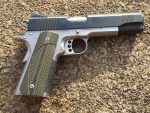
I’m a sucker for well-made 1911 handguns, especially when chambered in .45 ACP. It is just hard to beat this combination. I don’t think that John Moses Browning had any idea that his 1911 design would be popular for so long. We are closing in on 109-years since the 1911’s adoption by the U.S. military. Who would have believed that a gun that was first designed around 1904 would still be alive and kicking more than a century later. In fact, .45 ACP M1911 variants are still in limited issue by the U.S. Marine Corps, as the M45A1. The USMC says that they have “plans” to phase them out, by 2024. I won’t believe that until it happens.
I’ve tried – a number of times, to count the actual number of companies who are producing 1911 handguns these days. Im sure its safe to say that there must easily be at least 60 or 70 different companies producing M1911 variants. And, the number of different models – as they say in the current parlance: “OMG! “It is impossible to count how many different models there are – from a shorty “Officers” model, to the “Commander-sized” to the Government sized, to long slides and everything in between! I cut my teeth on a full-sized Government Model, but I knew there were Commander-sized M1911s out there – in all-steel as well as with a light-weight Aluminum frame. I’ve surely owned several hundred M1911s over the past 50 years.
Like everyone out there, who owns and shoots a 1911 handgun, I have my favorites, and hands down, I much prefer the Commander-sized, light-weight version – that’s one with a barrel length of 4-inces to 4.5-inches – depending on which company you decide to buy from. For a lot of years, I carried a full-sized Government Model 1911 and it was very comforting on my hip. However, as I grew older – and believe me, the years start to fly by, as you grow older, I decided on the Commander-sized, light-weight 1911 in .45 ACP. I still get this question, all the time from readers, and friends, “what is your favorite gun?” And, that covers a lot of territory. I believe they are asking what is my favorite handgun, and I still struggle with this one. For many years, I would simple answer a 1911 – without picking one particular model.
If push came to shove, I would still pick the Commander-sized 1911 over all the other versions. However, I don’t believe I would pick the 1911 – in any version, as my one and only handgun for an End Of The World handgun. My choice would be the Glock 19X over the 1911, for a number of reasons. One would be, the capacity – the Glock 19X comes with 17 and 19 round magazines, and a handgun chambered in 9mm with 19+1 rounds is hard to beat, when the lead is flying in my direction. There I said it, the 1911 wouldn’t be my first choice as my one and only handgun for the End Of The World any longer. Whew, got that one off my chest – at long last. Nothing “wrong” with a good ol’ 1911, but more ammo on-tap is more comforting to this old gent these days.
My local gun shop is always getting in some great deals on firearms, since they are also a pawn shop. Many times, a gun comes out of pawn, because the person who pawned it, didn’t pay the pawn ticket off, and the shop can then sell it. And, there are fantastic guns and prices to be had. I picked-up a Kimber Custom II, two-tone Government Model for $625 and it was like-new. A steal of a deal in my book.
Kimber is the largest maker of 1911s. They have been for a lot of years – kicking Colt back towards the end of the line. There’s a real good chance, if Kimber doesn’t have what you are looking for in a 1911 – then no one does. I still remember when Kimber’s first hit the market, they offered a near custom 1911, for only slightly more than what others were charging for a plain-Jane 1911. However, the Kimber line had many features, that you normally would pay a custom gunsmith to add to your standard 1911. To wit: a match-grade trigger, high visibility sights, an extended beavertail grip safety, and extended and ambidextrous thumb safety, and many other custom features. You would otherwise easily pay several hundred dollars for these to be added to your 1911.
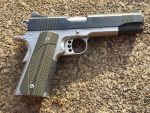 A quick look at the Custom II Government Model is in order. First of all, as mentioned, it is a Government Model with a 5-inch barrel and slide, and a full-length grip, and a single 7-round magazine. The slide is nicely blued, while the frame is stainless steel. The front of the slide has angled serrations on both the front and the rear of the slide. The match grade Aluminum trigger breaks between 4-5 pounds – and it is crisp. The magazine well is slightly tapered for a sure reload, as well. The gun weight about 38-ounces with an empty magazine. There is a full-length guide rod, but I can live without that. I much prefer the GI standard guide rod. Is houdl also mention that the match-grade barrel is also stainless steel.
A quick look at the Custom II Government Model is in order. First of all, as mentioned, it is a Government Model with a 5-inch barrel and slide, and a full-length grip, and a single 7-round magazine. The slide is nicely blued, while the frame is stainless steel. The front of the slide has angled serrations on both the front and the rear of the slide. The match grade Aluminum trigger breaks between 4-5 pounds – and it is crisp. The magazine well is slightly tapered for a sure reload, as well. The gun weight about 38-ounces with an empty magazine. There is a full-length guide rod, but I can live without that. I much prefer the GI standard guide rod. Is houdl also mention that the match-grade barrel is also stainless steel.
The used, but “as-new” Custom II that I picked-up was a slightly older model – no dots on the sights – just all-black – a bit hard for me to see, so I used some red nail polish on the front sight – what a difference it made – it popped out when aiming. This model also had a single-side thumb safety that I much prefer over the ambidextrous safety. Plus, the beavertail grip safety that released about halfway through as you depressed it – timed just perfectly if you ask me. The nicely blued frame is made out of carbon steel. And as I mentioned, the slide is stainless steel – a nice contrast.
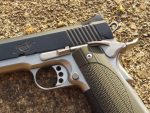 The gun same with some G-10 greenish grips, instead of the wood grips that were supplied by the factory, and I normally swap out grips on 1911s with a set of my own design “Code Zero” 1911 from www.mil-tac.com that I much prefer. However, I left the greenish G-10 grips on this gun for some reason. The only changes I preformed where to install an 18.5-pound heavier recoil spring, because I shoot a lot of +P .45 ACP ammo in my 1911s. I also added a strip of skate board tape to the front strap, for a sure grip under any weather conditions – I do this with all 1911s that have a smooth front strap.
The gun same with some G-10 greenish grips, instead of the wood grips that were supplied by the factory, and I normally swap out grips on 1911s with a set of my own design “Code Zero” 1911 from www.mil-tac.com that I much prefer. However, I left the greenish G-10 grips on this gun for some reason. The only changes I preformed where to install an 18.5-pound heavier recoil spring, because I shoot a lot of +P .45 ACP ammo in my 1911s. I also added a strip of skate board tape to the front strap, for a sure grip under any weather conditions – I do this with all 1911s that have a smooth front strap.
I don’t like carrying full-sized heavy handguns these days, I hope I’m growing smarter as I age, and I can usually be caught carrying my GLOCK 26. However, I packed this Kimber for two weeks in a Blackhawk Products SERPA hip holster, and for hiking the logging roads, when I get a chance, I use the Blackhawk SERPA tactical thigh holster and both of these holsters were a great match-up for this Kimber Custom II.
Some Target Shooting Tests
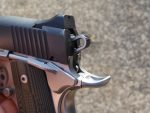 Lots of talk about how nice this Kimber was, but could it shoot? From the great folks at Black Hills Ammunition, I had a great assortment of .45 ACP to test in this Kimber Custom II. I had the Black Hills 230-gr FMJ, 185-gr JHP, 230-gr JHP, 230-gr JHP +P, 185-gr Barnes all-copper hollow point +P and my favorite from them, their HoneyBadger 135-gr solid copper fluted round. All accuracy testing was done at 25 yards, over a rolled-up sleeping bag over the hood of my prized Dodge Ram pick-up. I only had one volunteer shooter on this outing, and we had a lot of fun shooting this Kimber. The Black Hills 230-gr JHP +P load was stout – very stout – so it should make a great self-defense load, or a good load for the trail against 4-footed critter defense. The HoneyBadger had the lightest recoil — to be expected with that light 135-gr bullet.
Lots of talk about how nice this Kimber was, but could it shoot? From the great folks at Black Hills Ammunition, I had a great assortment of .45 ACP to test in this Kimber Custom II. I had the Black Hills 230-gr FMJ, 185-gr JHP, 230-gr JHP, 230-gr JHP +P, 185-gr Barnes all-copper hollow point +P and my favorite from them, their HoneyBadger 135-gr solid copper fluted round. All accuracy testing was done at 25 yards, over a rolled-up sleeping bag over the hood of my prized Dodge Ram pick-up. I only had one volunteer shooter on this outing, and we had a lot of fun shooting this Kimber. The Black Hills 230-gr JHP +P load was stout – very stout – so it should make a great self-defense load, or a good load for the trail against 4-footed critter defense. The HoneyBadger had the lightest recoil — to be expected with that light 135-gr bullet.
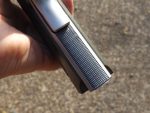 If I was on my game – and that isn’t all the time, I was getting 3-inch groups with most of the loads, and one load that stood out, was the 230-gr JHP load – not the +P – but the standard velocity load. I got a couple groups just right at 2.5-inches – but I think the gun could do better on a better day, with me behind the trigger. If I believe I’m having a really bad day, doing my accuracy testing, then I’ll set those results aside, and come back a few days later and reshoot for groups. Makes a big difference when you take a day or two off. Sometimes, after shooting for several hours – at “fun” targets, your nerves start to get rattled after a couple hundred rounds, and you may not be at your best that day, when the accuracy portion of my testing arrives.
If I was on my game – and that isn’t all the time, I was getting 3-inch groups with most of the loads, and one load that stood out, was the 230-gr JHP load – not the +P – but the standard velocity load. I got a couple groups just right at 2.5-inches – but I think the gun could do better on a better day, with me behind the trigger. If I believe I’m having a really bad day, doing my accuracy testing, then I’ll set those results aside, and come back a few days later and reshoot for groups. Makes a big difference when you take a day or two off. Sometimes, after shooting for several hours – at “fun” targets, your nerves start to get rattled after a couple hundred rounds, and you may not be at your best that day, when the accuracy portion of my testing arrives.
In all, we fired more than 300 rounds during our testing, and the Kimber never missed a beat – not a sign of a bobble at all. Kimber used to recommend that you fire 200 rounds through their 1911s, to make sure they are broken-in – that’s a lot of ammo and it can be spendy to say the least–especially with the current COVID-19 ammo buying frenzy. I’ve only owned a couple Kimber 1911s that actually required a break-in period, but all the rest were good to go, right out of the box.
You could do a lot worse than a Kimber in the way of a 1911 if you ask me. Prices are usually right close to retail on a Kimber, because they are always in-demand. If you find one that you like, put your cash on the counter, ‘cause if you don’t, the next guy who picks it up, will buy it.
